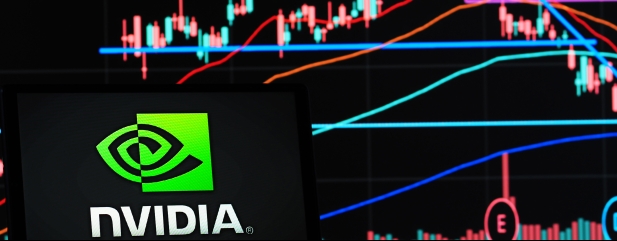Archived article
Please note that tax, investment, pension and ISA rules can change and the information and any views contained in this article may now be inaccurate.
Nvidia stock strikes new all-time high

On the last day of June, AI (artificial intelligence) chip design champion Nvidia (NVDA:NASDAQ) set a new all-time share price high closing at $157.99.
The new record values the company at $3.85 trillion, making it once again the world’s most valuable company, ahead of both Microsoft (MSFT:NASDAQ) at $3.7 trillion and Apple (AAPL:NASDAQ) at $3.06 trillion, the only other listed companies to top the $3 trillion mark.
It also gave sceptics another bloody nose, having risen nearly 70% since a rout in early April when the US president unveiled reciprocal tariffs for trading partners around the world.
During several sessions following Trump’s trade-relations bombshell, Nvidia shed close to $270 billion of market cap.
At the time, JPMorgan analyst Harlan Sur wrote in a note that he estimated the trade rules could cause an 8% to 10% drop in Nvidia’s full-year data centre revenue and EPS (earnings per share).
In other words, Nvidia would see $15 billion to $16 billion in lost revenue. Jefferies analyst Blayne Curtis was also gloomy, albeit predicting a more modest $10 billion hit to revenue.
Less than three months on, things look very different, and Nvidia is pushing the $4 trillion market cap mark, which would be a global first.
To do that, the stock price would need to close at $164.15, according to Shares own calculations, just 3.9% above current levels.
Investors optimistic about Nvidia’s medium-term prospects may even believe a $5 trillion valuation is not out of the question later this year or during 2026.
Sceptics will scoff, after all no company has ever been valued at $4 trillion before, let alone $5 trillion, but running the numbers shows the prospect is not as outlandish as it might appear.
Looking at current consensus forecasts for this full year plus the following two years, we calculate analysts are anticipating average annual revenue and EPS growth of around 30% for both metrics over that timeframe, implying an average three-year PE (price to earnings) ratio of 29.3 times.
The forecasts also imply an average three-year PEG (price to earnings growth) ratio, a metric used by many growth-focused fund managers, of 0.94 times, firmly in the attractive zone.
So, what would the three-year average PE and PEG ratios look like at a $5 trillion market cap? To hit this mark, it would require the stock to rally roughly 30% to $205.
Assuming no changes to forecasts over same period, Shares calculates Nvidia’s average three-year PE would stand at 38.1 times, still below the five-year average, based on Koyfin data.
The three-year average PEG would stand at 1.2 times, significantly below the PEG ratios of the rest of the 10 largest companies in the S&P 500 index which range between 1.8 and 3.2 times.
Important information:
These articles are provided by Shares magazine which is published by AJ Bell Media, a part of AJ Bell. Shares is not written by AJ Bell.
Shares is provided for your general information and use and is not a personal recommendation to invest. It is not intended to be relied upon by you in making or not making any investment decisions. The investments referred to in these articles will not be suitable for all investors. If in doubt please seek appropriate independent financial advice.
Investors acting on the information in these articles do so at their own risk and AJ Bell Media and its staff do not accept liability for losses suffered by investors as a result of their investment decisions.
 magazine
magazine








